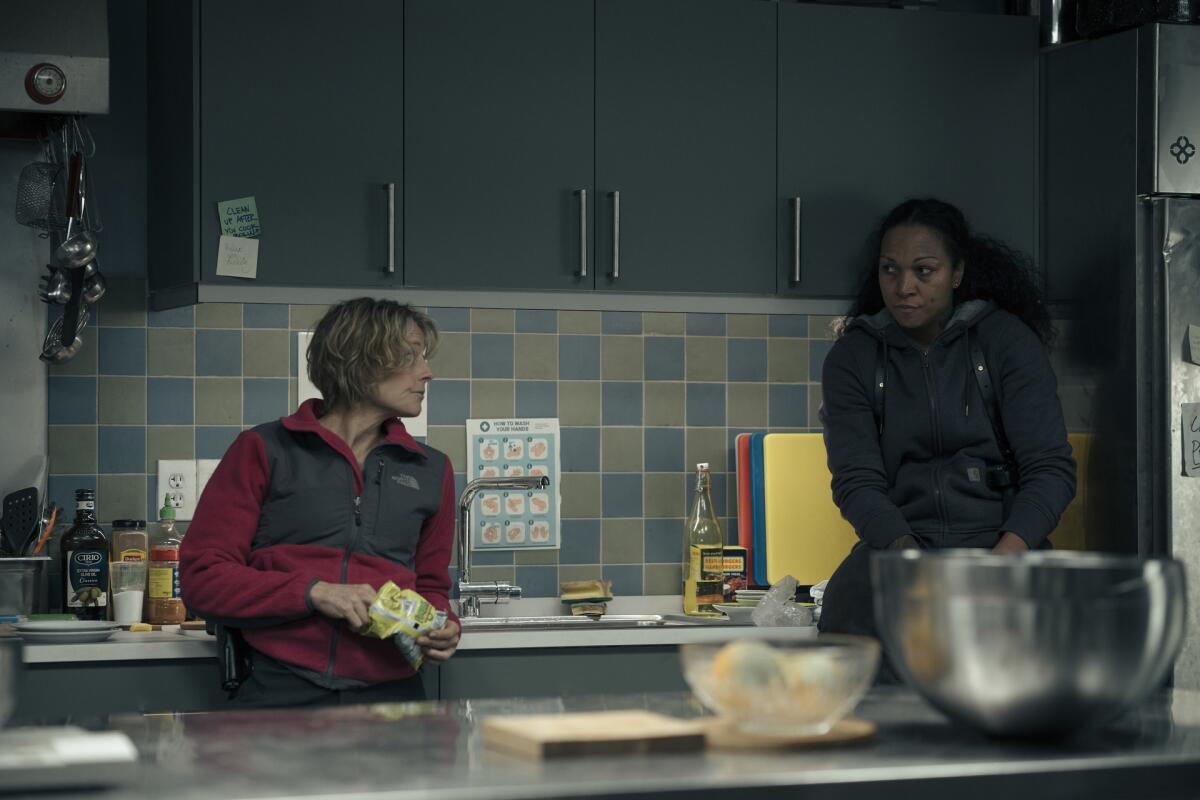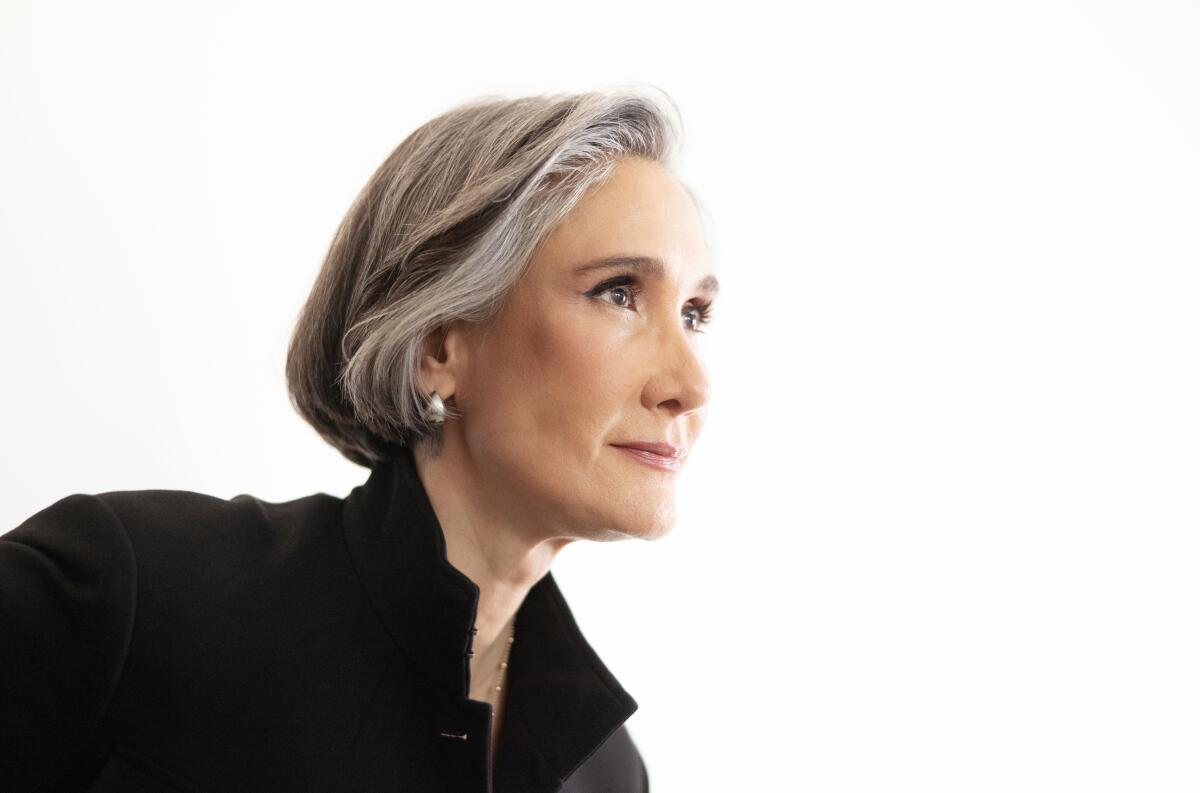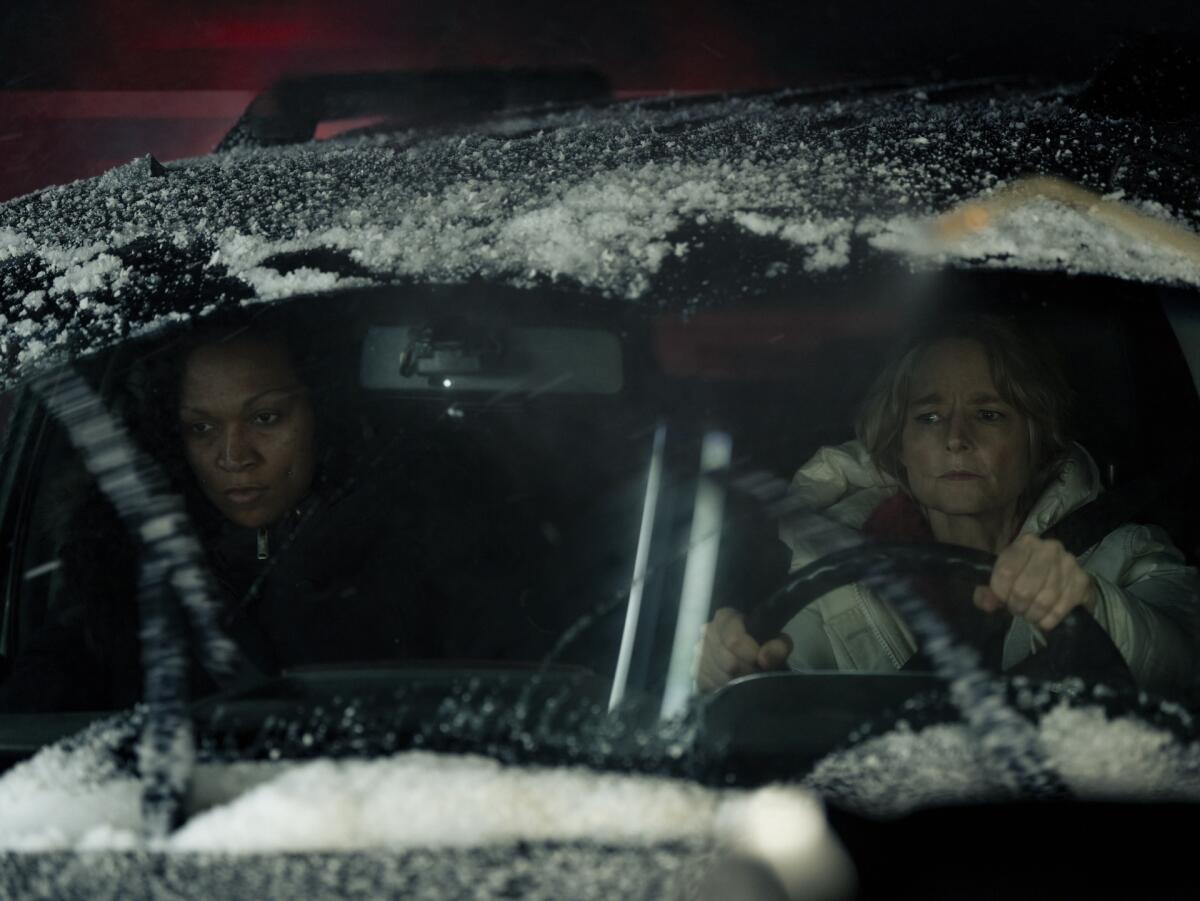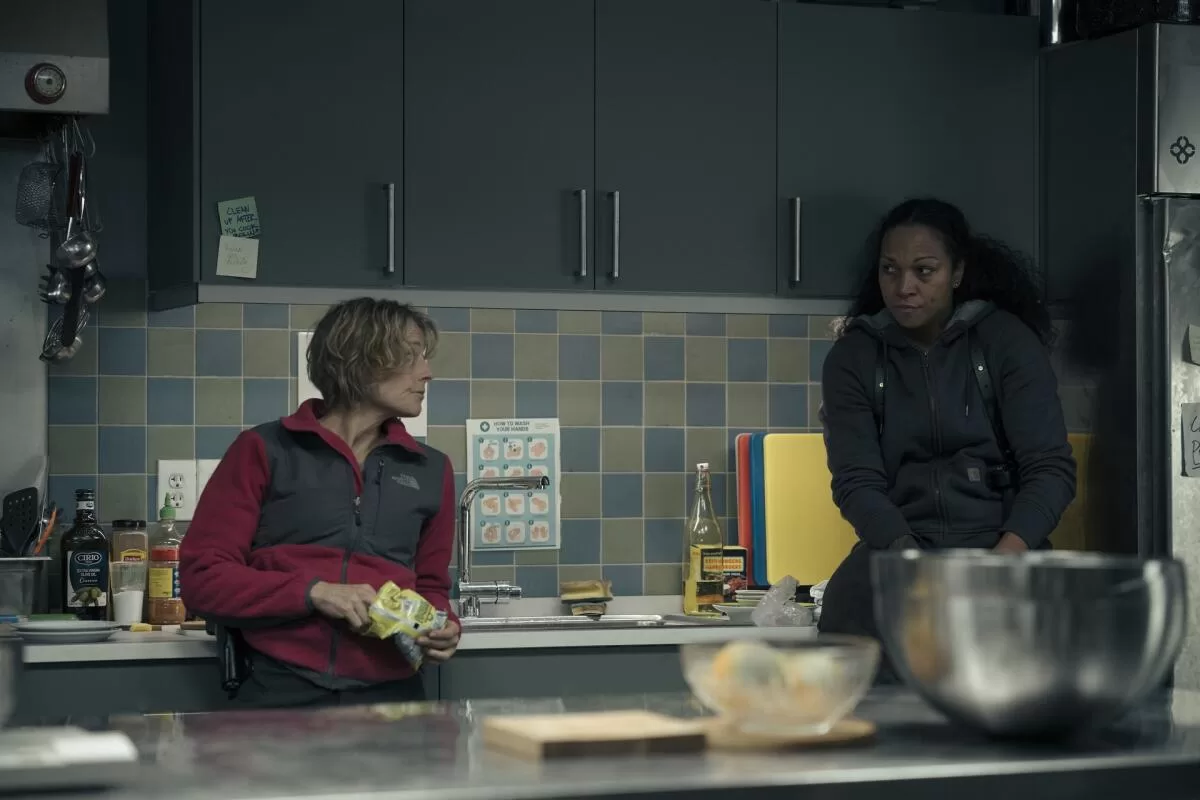The darkness has lifted, “True Detective: Night Country” has come to an end, and some of us may never look at an orange in the same way again.
Written and directed by Issa López, the latest incarnation of the anthology mystery series relocated the action to the fictional town of Ennis, Alaska, and follows two women — Liz Danvers (Jodie Foster), the local police chief, and Evangeline Navarro (Kali Reis), a state trooper, as they investigate the mysterious death of a group of scientists at an Arctic research station — all while trying to heal the wounds of their past.
Invoking familiar “True Detective” imagery (creepy swirls) while introducing all new eerie iconography (one-eyed polar bears), “Night Country” put a welcome, feminist spin on the franchise after a four-year hiatus.
Leading into Sunday’s finale, many unanswered questions remained, starting with who — or what — was responsible for turning the Tsalal scientists into a corpsicle, who really killed Annie K., and how her tongue ended up at the research station six years after she died.
Over the course of the New Year’s Eve from hell, Danvers and Navarro make one bombshell discovery after another, learning that: 1. the scientists at Tsalal were pushing the mine to pump out more pollutants because it made it easier for them extract DNA from the ice; 2. Annie found out about it and destroyed their research; 3. the scientists killed her in a collective fit of rage; 4. members of the cleaning crew discovered the ice cave, where they saw the evidence of Annie’s murder; 5. they returned to the research station, forced the scientists out onto the ice in the middle of a storm, made them strip, and left them there in an act of revenge that proved fatal to them all; 6. except Raymond Clark, who hid in the abandoned ice cave for weeks until Danvers and Navarro found and interrogated him; 7. and he wound up becoming a corpsicle, too.

(Michele K. Short / HBO)
Phew. Got all that?
The episode ends on a decidedly ambiguous note, however. An epilogue skips ahead four months to May. Navarro has seemingly vanished and Danvers faces questioning by investigators about the events of the previous December. She is evasive when asked about reported sightings of Navarro — who we see walking onto the ice, alone, then standing on a porch next to Danvers in the parting shot of the season. Is it really her? Or just an apparition? It’s impossible to say. “This is Ennis, “ Danvers tells the investigators. “Nobody ever really leaves.”
Speaking recently by Zoom, López broke down the series finale and was, thankfully, willing to answer more questions than Danvers. This conversation has been edited and condensed for clarity.
It turns out the women of the cleaning crew were responsible for the deaths of the scientists at Tsalal — or at least they are the ones who drove the men out into the cold. Did you always know that would be the outcome?
I knew from the very beginning. Being Mexican and having moved to Los Angeles some 10 years ago, it’s interesting to see how behind every scene, there is someone you would never notice. I’m Mexican, and most people in California are Mexican or Latin American. They’re the person that washes the dishes, the person that cleans the office after you leave. They’re really invisible. However, they’re everywhere, they have access to everything, they know everything. Invisibility is a superpower. It can be terrible. And it can be conducive to horrors like missing and murdered Indigenous women. But at the same time, it can be a superpower. Why not flip that coin and use it for power?
The scientists turn out to be the bad guys in this story. They’re willing to kill Annie and pollute the town in the name of scientific progress. How did you decide to make them the villains?
That’s a tough decision for me. I’m a massive believer in science. If there’s a religion for me, it’s science. The idea that ancient DNA can be used is not impossible, it’s not madness. But it would be very hard to extract. All of that is factual. The pursuit of knowledge or any greater good without a moral compass, I think, is the question of our age, as we look at what’s happening with AI and so many technologies that put the human race in a place that we never imagined. I don’t know if there’s a moral compass behind those. I don’t think we’re growing morally at the speed that we’re growing intellectually. And that’s a very dangerous place to be. If you abandon responsibility for the greater good, it’s very, very dangerous. It’s not about the pursuit of knowledge, it’s absolute self-obsession. It’s egotistical. In the traditional Greek tragedy, the mistake of the hero is always taking endeavors that go beyond the human. When you overstep human capacities, it ends in tragedy. So I just went with the Greeks on this one.
The version of Alaska that a lot of us know through pop culture is this male-dominated frontier with fishermen and ice road truckers. In your version of Alaska, it’s the women who dominate and the men who seem lost. Were you consciously trying to present a different idea of Alaska?
I think that the male and female characters in the series are democratically helpless, in the sense that everyone is lonely — men and women. Everyone is a little terrified of the stuff that they carry inside of them, perhaps with the exception of [Eddie] Qavvik on the male side — that guy’s fine — and Rose on the female side. They have their s— figured out. Everyone else is completely lost and trying to find their own path. It’s the nature of this town at the edge of the world, at the edge of civilization, at the edge of reality.
The Alaska that you were describing is predominantly male in its presentation. And the Alaska that I explored is predominantly female, the characters leading the conflict and the drama and the decisions are female. That comes from my understanding of these communities — Nome and Katovik and Utqiagvik [Alaska] — these communities [can be] 70% [or more] Inuit and particularly Iñupiaq. The strength of the Iñupiaq women is key to their survival. They’re just as much the hunters and fishers. They’re dog-sledding. They’re just indomitable. It’s incredible. Putting that in there felt very necessary.

Issa López, writer, director and showrunner of “True Detective: Night Country.”
(Christina House / Los Angeles Times)
A number of Indigenous women were consultants on the series. What kind of perspective and input did they bring?
I conceived the idea when we were in the lockdown. I couldn’t just pick up and go to Alaska and write it, which is what I wanted to do. I had to do the first passes based only on watching endless hours of “Alaska State Troopers” and “Life Below Zero,” which, by the way, I recommend.
I consumed hours and hours of social media of the people living in these towns. I listened to local radio stations while I was writing the scripts. Once I had an initial pass, we worked together through an association called Illuminative, which is amazing and connected us with two Alaskan producers [who were] very much in contact with the culture. They put together a council of the elder women of the Iñupiaq. When you say “elder,” I always think “ancient,” but there were women of [age] 45 and women of 90. They went through every single page of the scripts. I would mention elk, and they would say, “There’s no elk, not in that region.” [They provided details] like the type of fish, or how would they address someone coming into their house and insulting them.
Then I went to Alaska and I ate the animals that they hunted, we broke bread and I drank the wine that you have to get in the depot. I brought all that into the scripts and then some of the women in the elder council actually appeared in the series. They came with the clothing they made and they cooked the food that we served to the characters in the series. It was just beautiful. They became completely intertwined with the fabric of the series. They’re watching and loving it, which makes me endlessly proud.
I’ve watched the finale twice now. I’m still trying to figure out how literally I should interpret the final shot, with Danvers and Navarro on the porch. I assume you wanted to leave us with a mystery to think about. Tell me about that.
I think that the entire series has two readings. One of them is that everything is connected to the supernatural. The other one is there’s absolutely nothing supernatural happening. The dark brings its own madness and neurosis to some characters. The men walking onto the ice — you can go with they froze to death in a flash freeze and they had paradoxical undressing and delirium because of hypothermia. Or [you can believe] they walked onto the ice, and faced the thing they woke up by being in the wrong place. It’s up to you to decide which one of those readings you are going to embrace.
Navarro asks in the series, “Don’t you ever feel that you just want to go and walk away and never come back?” She talks about getting calls from something that has called the women in her family for generations. She’s terrified. In the climax of Episode 6, she goes into the darkness on the ice. When she finally surrenders to [the calls], in peace, she receives a piece of herself that she was missing: her name. That part of her is complete.
The part of her that wants to just go away is still there. Danvers says, “If you ever go, please come back.” In the very last part of the episode, we see her at peace. It’s up to her to decide if she goes on a walkabout to find herself and come back, as Danvers asks, or if she goes to be with the other women in peace, and is visiting as an apparition. It’s up to you to decide which one of the two it is. I have my version, but I’m not going to tell you.

“I think that the entire series has two readings. One of them is that everything is connected to the supernatural. The other one is there’s absolutely nothing supernatural happening,” says Issa López.
(Lilja Jons)
Clark says “time is a flat circle,” a callback to what is probably the best known line of dialogue from the original season. How’d you decide to bring that line in the episode? And did you have any anxiety about such a recognizable callback?
Here’s the thing. I never set out [like], “Oh, let’s put everything we can that references Season 1.” I believe in the idea of letting the story speak to you. I decided that Alaska was a super interesting setting for this series. I rewatched Season 1 and I realized Rust Cohle’s father had lived and died in Alaska. It would be crazy to never mention it. It’s the same universe. There is a corporation that is funding the endeavors of a greedy machine that is lying about pollution. In Season 1, there is an evil corporation too — it would be silly to have two different ones. When there is a symbol in my season that signifies the proximity of a different level of reality — the supernatural — and there is a symbol for that in the first season. So why add in a new one? That just makes it not “True Detective.”
The idea in Clark’s crazed mind [is] that Annie’s spirit has always inhabited this cave, because maybe Annie is herself, in a way, whatever was sleeping there. Annie’s friend tells us she dreamed about this spiral when she was in school. Clark [tells Danvers], “She has been there forever, she will be there forever.” it’s just absolutely natural that he says, “Time is a flat circle.” That is a concept that comes from quantum physics. He’s a scientist, so it’s the most organic thing.
The other unresolved mystery is the tongue. How does that fit in?
Same story. If we’re going to go with the supernatural story, Hank is the one that dumps [Annie’s body] and cuts out the tongue. He leaves the tongue there, and the tongue disappears. No one ever finds it until six years later. In the moment that the scientists face their fate, the tongue reappears because it’s the time to tell the story that was silenced before. Was it Annie’s ghost?
If you’re going to go rational, Hank cuts the tongue and leaves it there. And then the body is found, not by Navarro — Navarro is the first cop at the scene — but by the community. In my mind, the women find Annie and they cannot take her body, but they can keep her tongue in a gesture of kindness for their friend. Danvers says it has some unusual cellular damage, it could be from freezing. They keep the tongue, they freeze it and when they go into the research station [to attack the scientists], they leave it there: Full circle. Time to pay. You can decide which one you believe.
Can you talk about how the ice becomes a border between the human and the supernatural, the living and the dead, especially in this last episode?
It’s absolutely at the center of the entire narrative. If you look at the title sequence, it’s all about that; we’re on this road that will expose what’s under the ice. When I picked the setting, [I was interested in] the idea of the things that we freeze inside ourselves, and hide under ice, so we cannot access them. However, the ice breaks, and the things that lie beneath will come to light. The ice won’t last forever. It is a massive metaphor, and it is at the very center of everything we’re saying in this story.
